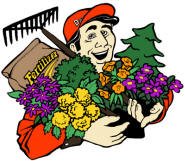Thursday, December 20, 2012
Dayton "Dirt" - December 21, 2012
Today is the first day of winter that is starting to feel like winter although the winters of the late 1970's were much colder with some days sporting a high for the day in the single digits!
Besides the Christmas season winding down, this week has been finalizing the inventory of hard goods and plants so that when our new software is up and running, a live inventory will be available on line. With the constant and instant updating of inventory, what is currently “on hand” will be much more accurate; that is, as long as everyone cooperates as far as committing and deleting inventory with accuracy.
Most inventory line items will then have a “thumb nail” icon next to each listing in which the viewer can click on to produce a clear, enlarged color photograph and a brief description of the plant.
The amount of cut Christmas trees has dwindled although the Scotch Pine and Fraser Fir available are still quite nice. We’re now discounting the trees in the amount of $10 less for the Scotch Pine and $20 less for the more expensive Fraser Fir. Grave blankets will still be available for pick up or delivery until 3 p.m. on Christmas Eve.
In 4 days Christmas will arrive bringing in a day of joy, togetherness, peace and quiet and excitement all mixed together.
Joyeux Noel
Tom
Friday, December 14, 2012
Dayton "Dirt" - December 14, 2012
With only 11 days until Christmas, the weather has been more like spring than December. The slow soft rain has rehydrated the ground from last summer’s drought which will do well for the water table especially important for all of us that depend upon wells.
Already the Christmas season is slowing up somewhat at the nursery as our tree selection is starting to thin and the grave blanket production is winding down. In just the past 10 days though the colored brachts on the poinsettias seem to have enlarged so much so that only a limited amount of foliage is visible.
Bulb planting is still continuing after we planted 2,000 tulip bulbs last week only to be followed by more hyacinths and another 1,000 bulbs to go elsewhere on the grounds for late April and early May bloom.
This past week while the weather turned warmer and sunny, we did apply some fungicide to the plant storage houses as well as a 20% bleach solution to the German Iris to prevent bacterial infections caused by the humid conditions.
More improvements are still going on the grounds and building so that they may be completed before the busy spring which for us starts the last week of February due to our growing operation.
Remember that since our selection of plants is limited at this time of year, a gift idea would be a gift certificate from Dayton’s that never expires and never has a “service” fee that reduces its value.
Stop by soon.
Tom
Thursday, December 6, 2012
Dayton "Dirt" - December 7, 2012
With the weather so mild for this time of year problems can arise in our plant overwintering huts from the fungus known as Botrytis. The disease is a gray mold that will grow on plants when the temperature is 29º F or greater and relative humidity is at 50% or more. The damage this fungus causes is quite severe from the destruction of foliage as well as the flower beds of some of the flowering plants.
In order to check the spread of Botrytis, we ventilate the houses when temperatures will not drop to less then 25º F overnight. In addition, fungicides that prevent the fungus from growing are sprayed monthly as long as the temperature is just above freezing.
More planting and construction is going on at the nursery before we are forced to move inside because of the inclement weather. Another relatively good weather project is the annual planting of between 1,000 and 2,000 flower bulbs of hyacinths, tulips and narcissus to our growing collection. One fall, winter came early and we were left with 10,000 daffodils that were packed in crates until February. If the bulbs were not planted by the first of March, they would need to be thrown away as the cold period required for growth and bloom in spring could not be achieved.
The result was a sod cutter on a grassy muddy hill where the snow melted and three of us digging trenches 6" deep to plant the bulbs in long rows of about 100 feet each. What a miserable venture it was! The result in early May was a spectacular show of golden yellow daffodils and white narcissus with their cheerful orange colored trumpets making all the hard work worthwhile.
Christmas trees, grave blankets, poinsettias are the norm right now before we close the last day of December until March 1st. The slow period is just what we need to get ready for the next spring.
Tom
Subscribe to:
Comments (Atom)



